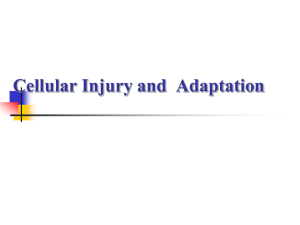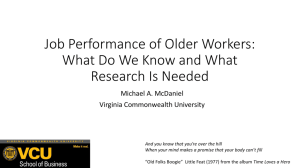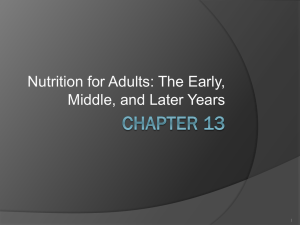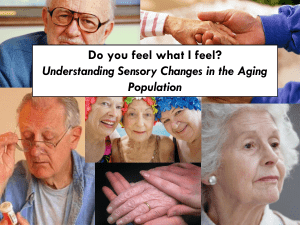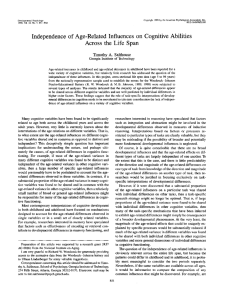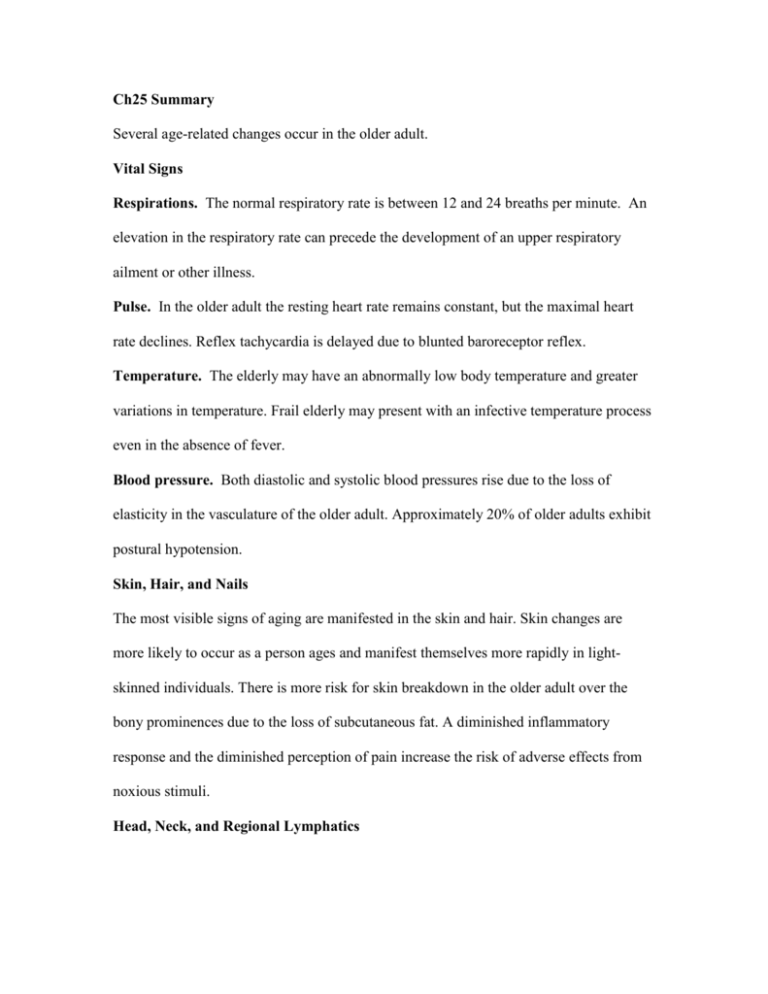
Ch25 Summary
Several age-related changes occur in the older adult.
Vital Signs
Respirations. The normal respiratory rate is between 12 and 24 breaths per minute. An
elevation in the respiratory rate can precede the development of an upper respiratory
ailment or other illness.
Pulse. In the older adult the resting heart rate remains constant, but the maximal heart
rate declines. Reflex tachycardia is delayed due to blunted baroreceptor reflex.
Temperature. The elderly may have an abnormally low body temperature and greater
variations in temperature. Frail elderly may present with an infective temperature process
even in the absence of fever.
Blood pressure. Both diastolic and systolic blood pressures rise due to the loss of
elasticity in the vasculature of the older adult. Approximately 20% of older adults exhibit
postural hypotension.
Skin, Hair, and Nails
The most visible signs of aging are manifested in the skin and hair. Skin changes are
more likely to occur as a person ages and manifest themselves more rapidly in lightskinned individuals. There is more risk for skin breakdown in the older adult over the
bony prominences due to the loss of subcutaneous fat. A diminished inflammatory
response and the diminished perception of pain increase the risk of adverse effects from
noxious stimuli.
Head, Neck, and Regional Lymphatics
The loss of subcutaneous fat and other musculoskeletal changes due to the aging process
affect the appearance and function of the head and neck.
Eyes
As we age, we have an increased risk of developing eye disorders. Presbyopia and
retinopathy are more common in middle-aged adults, whereas cataracts, glaucoma, dry
eyes, macular degeneration, and entropion or ectropion are more common in older adults.
Race also predisposes individuals to eye disorders. Glaucoma is more common in African
Americans, whereas melanoma of the eye is more common in Caucasians.
Ears
Hearing loss is a common presenting complaint among older adults. Conductive hearing
loss occurs in the outer or middle ear and usually makes things sound softer. The more
common age-related hearing loss is sensorineural. Changes also occur that can affect
balance and equilibrium.
Nose
Sinus and respiratory problems can occur in the older adult as a result of less efficient
filtration.
Mouth and Throat
There is a higher incidence of tooth loss and periodontal disease in the older adult; thus
oral hygiene practices need to be assessed and periodontal disease needs to be evaluated
because poor oral hygiene and periodontal disease are major causes of tooth loss.
Breast and Regional Nodes
Women who are older than 50 years of age; have a personal history of breast cancer; have
a mother, grandmother, or sister with breast cancer; reached menarche at an early age;
reached menopause at an advanced age; are obese; and consume three or more servings
of alcohol per day are at greatest risk for the development of breast cancer. Additionally,
breast cancer is more likely to affect women of American or European descent, women
who have never had a child or who gave birth to their first child after 30 years of age, and
women with a previous history of atypical hyperplasia.
Thorax and Lungs
Several age-related changes, both anatomic and physiological, occur in the thorax and
lungs of the older adult. The respiratory muscles atrophy, and chest wall expansion is
limited with age, increasing the work of breathing. The surface area for diffusion also
decreases, making alveolar gas exchange more difficult. The lung’s defense mechanisms
are also affected by age-related changes, which include decreased ciliary action,
diminished cough reflex, and an increased susceptibility to infection. The thorax and
lungs of older adults are also less able to quickly respond to changes in carbon dioxide
and oxygen, thus making older adults more at risk for respiratory complications.
Heart and Peripheral Vasculature
Cardiac output can fall by as much as 35% at rest after a person reaches the age of 70.
The cardiac valves may develop calcification or fibrosis, which can result in systolic or
diastolic murmurs. Changes in the conduction system can cause a variety of
dysrhythmias. Vascular integrity is also affected. The arterial system becomes
increasingly rigid as the blood vessels become fibrotic. Venous return to the heart is
affected, and edema or varicosities may develop.
Abdomen
The abdominal musculature diminishes in mass and loses much of its tone as a person
ages. Decreased esophageal motility and lower esophageal sphincter pressure can lead to
complaints of GERD symptoms. Malabsorption, altered digestion, and cobalamin
deficiency occur as a result of a decrease in pancreatic enzymes and hormonal secretions.
Musculoskeletal System
Several changes occur in the musculoskeletal system with advanced age. Bone density
decreases due to an increased rate of bone reabsorption. This change may be more
pronounced in women, due to the estrogen deficiency associated with menopause. As
bone density decreases, the bones become weaker, placing an individual at greater risk
for osteoporosis. Thoracic kyphosis and a reduction in height may also result due to the
decreased bone density. Muscle strength decreases and the muscles may atrophy, placing
an individual at increased risk for weakness. Additionally, the articulating cartilage of the
joints deteriorates, possibly causing pain, crepitus, and decreased movement.
Mental Status
Age-related changes to the neurological system are common. Older adults are at an
increased risk for ischemic brain injuries due to atherosclerosis of the cerebral arteries or
coexisting cardiovascular dysfunctions that limit the flow of oxygenated blood to the
brain. The myelin sheath degenerates, resulting in a decreased rate of nerve conduction.
Neurotransmitter production is decreased and degradation of neurotransmitters is
increased, placing the older adult at increased risk for depression and other diseases
related to a deficit of neurotransmitters. The number of neurons and synapses and brain
weight begin to decrease after age 50. The older adult may also experience sensory
changes to the auditory, proprioception, and visual systems. Decreased memory,
increased learning time, and changes in affect, orientation, and mood are common in the
older adult.
Reproductive System
Age-related changes to the female reproductive system begin between the ages of 45 and
55, with the onset of menopause. Low estrogen levels trigger the cessation of
menses. In general, the external and internal reproductive organs atrophy. The
pigmentation of the labia may decrease and the clitoris may atrophy. The pubic hair may
become sparser and gray or white. The ovaries, fallopian tubes, and uterus become more
difficult to palpate as they atrophy. Older women are more likely to experience vaginal
infections because the pH of vaginal secretions increases and the normal vaginal flora
decreases. The older woman may also experience dyspareunia due to decreased elasticity
of the vaginal walls. Additionally, the pelvic muscles atrophy, placing the older woman at
an increased risk for prolapse of the uterus and vaginal walls.
Age-related changes also occur in the male reproductive system. The penis and
testicles atrophy and appear smaller. Testosterone levels decrease in males over 50 years
of age. However, normal spermatogenesis is present in most men until age 70. Older men
are at an increased risk for impotence, frequently related to the presence of coexisting
chronic diseases or as a side effect of commonly used medications. Additionally, aging
causes an increased time to obtain an erection, and the erection may not be as complete.
Anus, Rectum, and Prostate
Age-related changes also occur to the anus, rectum, and prostate gland. Older adults are
unable to tolerate large volumes of feces in the rectum due to decreased muscle elasticity.
Decreased muscle elasticity places the older female at a greater risk for rectal prolapse.
Fecal incontinence may occur due to cognitive or nerve changes associated with chronic
diseases. Constipation is common in older adults due to many factors including lack of
exercise, poor diet, and medications that affect bowel function.
Copyright © 2010 by Delmar/Cengage Learning. All rights reserved.

